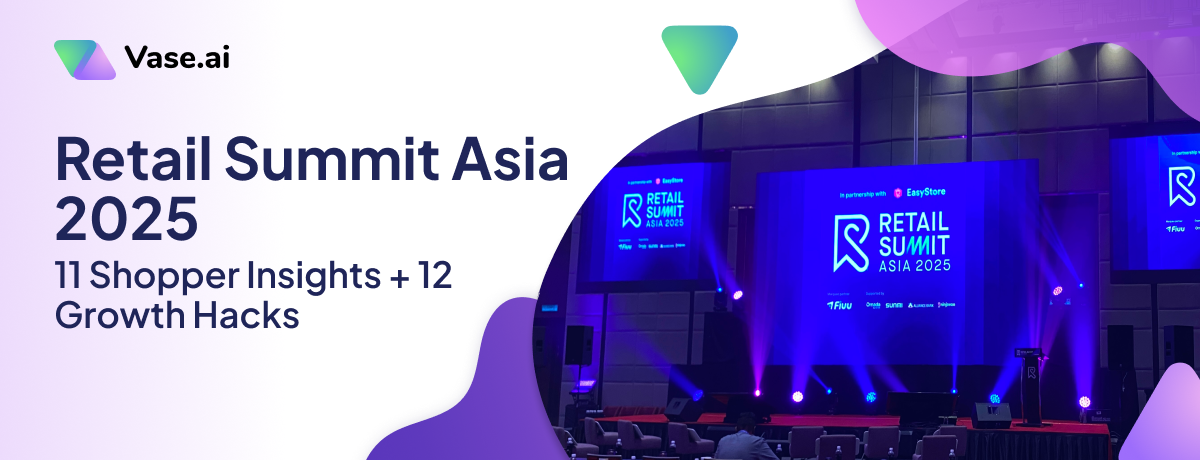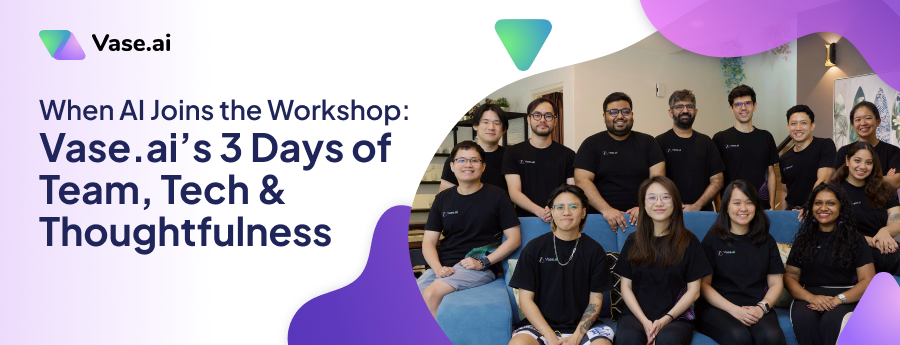It takes 20 years to build a reputation and five minutes to ruin it. If you think about that, you'll do things differently.
~ Warren Buffett
This quote by Warren Buffett says it all: building a brand is a tricky business. You'd certainly be forgiven for thinking about how to grow your brand deep into the night! So unless you're planning to bring down your brand (we know you're not), you'll always be looking for new ways to build your brand.
And who's a better person to talk about branding than someone who has done it successfully before?
Vase.ai had a chat with Anthony Low, former VP of Nestlé. He is now a mentor with Endeavor, inspiring entrepreneurs in Malaysia. In his vast 39-year experience in various positions like Supply Chain, Sales & Marketing Management, and Marketing Communication with the company, he definitely has a lot to teach on branding.
Here are the key takeaways from the fascinating webinar. Expect plenty of Nestlé and other brand references to hammer the points in!
1. Get your brand identity in order
Brand identity refers to the visible elements of your brand. Everything that the customer can see, touch and physically interact with is part of the brand identity. Elements of brand identity include the logo, brand name, colours, shapes, designs, tone of copy, social media presence and packaging.
Building a brand's identity takes the whole team. The whole design and implementation process must be clearly spelt out in your brand book, also known as a brand style guide. A brand book contains all the details on how the brand should look and feel. This is to ensure that no matter the brand touchpoint, the brand is consistently presented. Everyone knows their role in the brand-building process and how they should perform it.
An inconsistent brand brings down your brand rather than build it. It's harder for people to verify whether your business is authentic and whether the communication is directly from you. It also makes you look unprofessional, totally not a good look for any brand!
A well-defined brand is easily recognizable, looks professional and inspires trust and loyalty.
A brand should also have a clear direction, and some of the fundamental guiding principles are knowing your purpose and values. These help keep the brand outlast the rest of the competition and remain relevant for many years.
Nestlé has been in the food and beverage industry for 155 years now. Guess what hasn't changed?
Their guiding principles.
Nestlé's purpose is to enhance the quality of life and contribute to a healthier future. It is their purpose that drives them to make quality food that is healthy for people of all ages and pets. Their values are all centered around respect. Not just for individuals and families, according to the company, but also for the community and the planet.
Why are brand values and purpose important?
The marketplace is changing, and consumers are considering a brand's purpose and values in their purchasing decisions more than ever. They direct everything that a brand does, from making new products to marketing, customer relations and even employees' code of conduct. A good brand is a reflection of its values and purpose across all its touchpoints.
Get your branding right, and you venture into brand loyalty - which is where customers align with your core values and trust you with their money across the range of products you offer. Who wouldn't want that?
2. Your brand is the total experience your customers have
Often people think of a brand as the logo, the tag line, the slogan, colours and the like. This view of a brand is flawed-they are only part of the brand identity, but they are not the brand itself. A successful brand is more than just a name and a logo.
When building a brand, incorporate other elements such as brand personality, culture, values and purpose in addition to the other brand elements. Successful brands connect with their audiences not just physically but emotionally as well.
A brand is the sum of all your customers' experiences across your brand touchpoints, be it with the company, your product, or your service. The experience is both rational and emotional, though, for most people, emotional experience takes more precedence. The brand is a promise of what your company offers its customers and how you deliver them.
Strong brands make the customers feel and believe that they are trustworthy because they deliver on their promise. Effective brand building can bring a lasting impression on your consumers-an edge over the competition that is difficult to replace.
For example, the Coca-Cola brand promises the 'good feeling'- happiness, fun, and joy. It delivers so well on its promise that it's a billion-dollar company that has spread all over the world. It's so simple, yet so effective. Simplicity is the key to building effective brands.
3. Identify where and how you can make an impact
You cannot build and market a brand without knowing where it's intended for. Knowing your ideal consumer provides structure to the brand's interaction with the customer -you know what they want, how they want it and how to communicate with them.
It's not just about the numbers like the location, gender and age of your consumer base. Knowing your customers means going beyond the data and including other psychological, behavioural and environmental factors in the mix. If you understand them well, you can serve them well.
Nestlé has a strong focus on the consumer and is always looking for ways to make an impact in the community. What can your brand do for your town, community, country? To make the impact happen, the brand has to be on the ground and in touch with the people.
Visiting your current and prospective customers and interacting with them is a great way to find out the challenges they've got and how you can help make things better. In Nestlé, for example, senior managers and other managers are encouraged to make regular market visits as a part of their job.
Knowing where you can make an impact is only one half of the story-knowing how to make an impact completes the picture. Nestlé' makes an impact by conserving and taking care of resources for future generations. They also promote gender equality, inclusiveness and diversity - they've got over 80 nationalities in their global office. Nestlé not only provides healthier food options but also inspires people to lead healthier lives.
An example of this in action is Nestlé's Wellness Club. A market visit done in 2014 in Kaido, Japan, by Anthony showed that about 42% of households were living without their partners. They were, on average, above 50 years old. Nestlé found that so many people had an unmet need for dietary help, which was an area they could provide value.
They then sent doctors and dietitians to visit these individuals to assess their diets and physical activity. The team then developed personalized green tea, Anthony explains, that contains all the day's nutritional needs.
Nestle determined that they could impact the single, elderly individuals in society (the where) by providing assessments and products to solve their dietary needs (the how).
4. Your brand is your most valuable asset; invest in it
Let's bring in the Coca-Cola brand again. Its total market value in 2020 is 180 billion US dollars. According to Anthony's point of view, Coke's best seller is the brand itself! No matter your stand, brands are incredibly valuable for both consumers and the organization. Here's how:
- Brands create trust among your clientele.
A well designed and communicated brand has a higher chance of attracting and winning over customers than the rest. Branding helps motivate brand loyalty. Starbucks, for example, is associated with premium coffee and has a loyal following of consumers willing to pay more for the value. - Branding helps companies stand out in the market.
Brands uniquely identify a company from the competition and help it reach the target market. Coca-Cola, for example, is a recognizable brand all over the world, and that sets it apart from the rest of the market. Apple Inc is also a well-known brand in the smartphone industry, distinct from its Android competitors in the sector. - Branding promotes employee satisfaction and loyalty.
Employees working for reputable brands have a sense of enjoyment and fulfilment working for the company and are likely to stay around longer.
Investing in your brand is the best investment you can make in your business, to quote Steve Forbes' words. How does Nestlé do it? They put at least 16% of the budget of every new product they launch aside for brand building, or else it won't be approved. This is why the brand has a high product launch success rate.
Whatever you choose to invest in brand building, make sure it isn't nothing!
5. Leverage customer understanding into insights
Learned something from your clients? Brands that weave these customer insights into their processes are more likely to perform better on the market. Knowing your customers isn't enough; putting them first, understanding them and leveraging that understanding is what counts.
Nestlé uses a unique system known as Ownable Brand Proposition (OBP) to grow their brands. OBP means that you understand your target market enough to identify one key insight, which they call a human truth, to unlock doors to grow the brand.
An example of this in action takes place in Manila in 2003. Before an interview with the marketing team, a group of ladies was discussing how to keep themselves fit and their tummies flat. The marketing team there and then discovered a human truth- they have a concern and care about their tummy. Nestlé turned that into a hundred days challenge with Nestlé fitness.
Another example is an experience they learned in China. Nestlé noticed that young people were taking Nestlé products, looking at them for a while, then returning them to the shelves. On asking them for the reason why, the team discovered that the consumers are not only looking at the expiry date but also the manufacturing date. The human truth in this situation, they learned, is that they took products past 100 days as close to expiry, and they wanted fresh ones. It's no surprise that their market share began to shoot after they began offering freshly packaged products to the market!
6. Romance product truths
Your products should speak for themselves. Does your product provide something unique or something better than your competitors? Romancing that product truth means forming it into a narrative that can encourage your consumers to take action.
Anthony gave the example of Nestlé's Read the Label global program. Consumers need to make the right choices when selecting what to eat, and the program intended to do just that. Read the Label encouraged consumers to check what ingredients are contained in the product before making the purchase. They believed that their products spoke for themselves - a better, healthier alternative to the rest on the market. Their market share from the campaign in ASEAN countries grew, Anthony says, because people became more aware of what they consume.
Romancing product truths separates your brand from the rest. In a marketplace with plenty of similar products, your prospective clients won't know the difference, and you may not make the sale.
7. Learn from your competitors
Whether it's marketing or sales, customer service or research, there's always something you can learn from others and use to improve your brand. It doesn't matter whether the brand is big or small, there's always something to learn from the competition. Size brings arrogance, as Anthony says- you still need to put in the effort to learn even if you're a big brand!
There's a Chinese saying that only when there is competition you can have improvement. The competition isn't just there to compete for market share. It is there for you to learn from. Why is competition significant though?
- Competition breeds innovation. If all is well for your brand, it's very unlikely that you'll sit down to think of new ideas, and you'll just run on what's currently working. Competition forces brands to stay on edge and, if your competitors are using something to be better, you'll soon be out if you can't improve.
- Analyzing the competition fosters optimal decision making. Strong brands spend a lot of time studying the market and the competition to make the best decisions for themselves and the business.
Learning from the competition doesn't mean copying them. It is more of looking at anything that they do best and finding new ways that can help you improve your brand. It's not about the positives alone either; you can also look at what didn't work for them and find ways to make it better or avoid the same mistake.
8. Leverage technology to market your brand
The old marketing ways are soon becoming outdated. With the internet becoming more accessible to people, consumer expectations are getting redefined by the day.
Brand building in today's world is becoming more low cost and high impact, thanks to technology. While marketing isn't flawless now that computers are here, they certainly have made a few things better. For one, your brand has way more touchpoints with your customers, thanks to websites, social media platforms like Facebook and Instagram and even email. Digital marketing has also been made more efficient with customer relationship management software, data analytics and visualization tools, among many more products. Even for a low budget brand, there's a lot you can do to drum up excitement about your brand and engage with your consumers.
Anthony gave the example of Nestlé and Alibaba's collaboration which used technology to grow their brands. In 2012, the Chinese government encouraged young people to visit their parents whom they had left in their hometowns MD rural areas during Chinese New Year. Not many people visited their parents at the time.
The program was simple. If you couldn't visit your parents on Chinese New Year, you could send them a gift using the eCommerce firm Alibaba. The gifts would show that they still remembered and loved their parents. In the first year of the launch, the campaign made 9.3 billion US dollars, a figure that has never dropped since.
Final thoughts
Building brands successfully is not an easy task. With these few insights on brand building, however, you should be on your way to building a strong brand. Too long, didn't read? Anthony's top three takeaways for building your brand are:
- The customer is key. Know your target market deeply and understand them; they are a great source for insights that can open great doors for your brand.
- Understand and satisfy customer needs. The more you do, you earn their trust and, consequently, more business for your brand.
- Inspire with purpose and deliver on your brand promise.
Vase.ai is a consumer research platform that lets you engage with and get feedback from consumers in the ASEAN region. With as little as USD1,000, you can use the AI-powered system to get the valuable customer insights you need to grow your brand.





